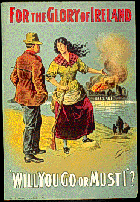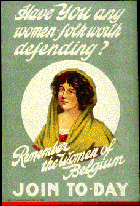According to the International Coalition of Irish American Student Organization, Kathleen ni Houlihan or Shan Van Vocht, “the poor old woman,” was derived from Irish mythology and became a symbol of the Irish Republic movement. During the resurgence of integrating folklore into Irish art in the 1890’s, W.B. Yeats and Lady Gregory utilized her as a character in their play Cathleen ni Houlihan (1902). She appeared in the play as an older woman requesting the young male protagonist to join the rebel against English colonization during the 1798 uprisings. The mythological connection to the struggles of that time resonated with the nationalist, thus making her an integral tool for the Irish Republican Army’s propaganda.

Wollaeger, Mark. Irish nationalist propaganda. Digital image. Seduction and Estrangement: World War I Recruiting Posters and the Politics of Ulysses. Web

Wollaeger, Mark. Irish nationalist propaganda. Digital image. Seduction and Estrangement: World War I Recruiting Posters and the Politics of Ulysses. Web.
The personification had major influenced the culture and way people spoke about the country. A popular example is in the dialog of Sean O’Casey’s Shadow of a Gunman (1923). The reuse of this name can also be found in the newspaper entitled Shan Van Vocht (1896-1899)- an independent and nationalist magazine edited by two women Alice Milligan and Anna Johnston, poets and activists of the self help movement and decolonization.

Pingback: How Politics Have Shaped Irish Theatre – An Exhibit at the Abbey Abbey Theatre | Irish Odysseys